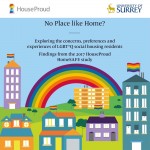Search Result
Housing and homelessness support
No place like home
 Despite changes in equality laws in recent years, Lesbian, Gay, Bisexual, Trans*, Queer and Questioning (LGBT*Q) people still face discrimination across a range of public services, including social housing. However, little is really known about the needs and views of LGBT*Q residents who live in housing provided by a housing association or local authority.
Despite changes in equality laws in recent years, Lesbian, Gay, Bisexual, Trans*, Queer and Questioning (LGBT*Q) people still face discrimination across a range of public services, including social housing. However, little is really known about the needs and views of LGBT*Q residents who live in housing provided by a housing association or local authority.
This study was conducted to find out, commissioned by HouseProud and conducted as HomeSAFE (secure, accessible, friendly, equal) by researchers from the University of Surrey and Goldsmiths, University of London. Over 260 people participated, through a survey, focus groups and interviews.
No place like home | University of Surrey | 2017
↑ Back to topSafety
Safety was a real concern for residents. 78% of survey respondents felt they lived in a safe neighbourhood. However, 32% felt their neighbourhood was not a safe place to live as an LGBT*Q person; this was 60% amongst trans* respondents. In interviews/focus groups people spoke of disturbing experiences of harassment and hate crime.Neighbours
This was an area of real concern for some residents. 34% of survey respondents were completely open with their neighbours about their sexual orientation, but 35% were not open at all. 36% reported that they were uncomfortable having neighbours in their home, a figure that rose to 91% for trans* individuals. Some residents spoke about harassment and abuse from neighbours, yet felt housing providers do not deal with it effectively.Operatives
21% of survey respondents reported that they were uncomfortable with repairs people entering their home and 24% their landlord.Self-censoring
Although a minority, a significant number of residents change their home environment in some way before people enter it to conceal their gender identity or sexuality. For example, moving pictures, books, DVDs. This was more common amongst gay men than other groups. 20% of gay men responded that they did this ‘always’ or ‘most of the time’ when being visited by their landlord or a repairs person. We found that women were less likely to let people into their home, but men were more likely to self-censor it. Overall, there is a strong degree of hypervigilance on the part of LGBT*Q residents.Extract courtesy of King, A., Stoneman, P and Sanders, F (2018) ‘No Place like Home? Exploring the concerns, preferences and experiences of LGBT*Q social housing residents. Findings from the 2017 HouseProud HomeSAFE study’. University of Surrey, Guildford.

